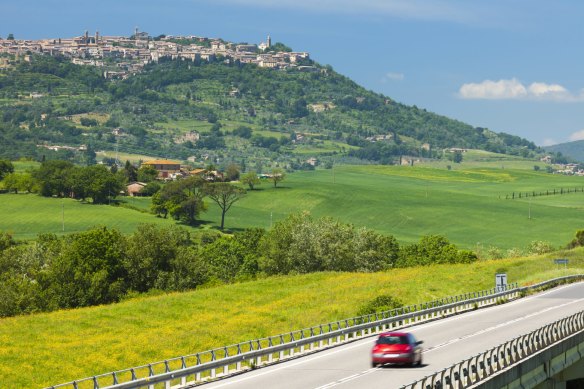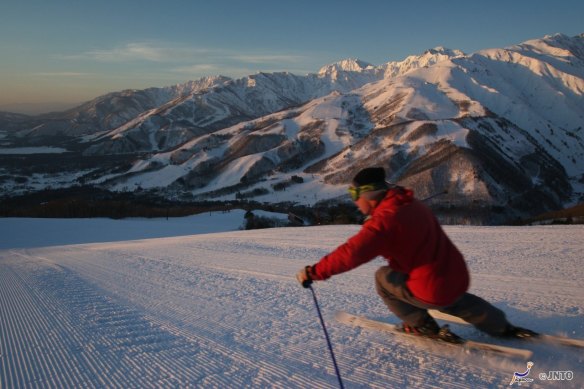Opinion
Tripologist: To visit Italy’s small villages, should you travel by car or train?
Michael Gebicki
The TripologistWe plan to travel to Rome then Puglia, up the east coast from Bari to Foggia, Pescara, Ancona, Rimini, Ravenna to Bologna. Should we do this by car, so we can visit small villages, or by train? We then plan to go to Piedmont, can you suggest a small town to base ourselves?
E. Plummer, Mont Albert VIC
You need a car, but if you’re not planning to make any stops between Rome and Bari I’d be inclined to take the train to Bari and pick up your hire car there. The trip takes just over four hours on the fastest trains and it’s a tedious drive if you’re on the autostrada the whole way. Take care driving through villages in Puglia, the roads are narrow and treacherous.

To visit the smaller towns in Italy, hire a car.Credit: iStock
In Piedmont I’d be planning two stops with about three nights in each. One is Bra, birthplace of the Slow Food movement, also known for its artisanal cheeses. It’s a middle-sized town with an excellent choice of dining and accommodation and is an ideal base for exploring the surroundings. Bra is close to the Barolo wine region, one of Italy’s most celebrated and photogenic. Second base, Orta San Giulio. It’s a hidden gem, a small town on the edge of Lake Orta. Explore the gorgeous surroundings, take a ferry out to San Giulio, the island in the middle of the lake, and don’t miss the ride on the Domodossola–Locarno railway line, the Vigezzina-Centovalli, one of the world’s greatest rail journeys.
We will be celebrating a 70th birthday on the ski fields as a group of 12 adults and five children. Currently we are considering Japan as dates will be December/January and want to avoid long-haul flights.
J. Toop, Hawthorn VIC
Located on the northern island of Hokkaido between volcanic cones, Niseko is rated one of Japan’s finest ski areas. Niseko gets an average dump of more than 15 metres of dry powder and the four interlinked ski resorts boast almost 900 hectares of skiable terrain, all accessible via an “All Mountain” lift pass. The season typically runs from November to March. There’s also a strong Australian presence here in the hotels and restaurants as well as on the snowfields.

Skiing at Hakuba in Nagano Prefecture.Credit: JNTO
Nagano might be a better fit since it’s more easily accessible from Tokyo, just a 90-minute ride on the bullet train. Host of the 1998 Winter Olympics, Nagano’s facilities are exceptional and thanks to the storms that funnel down from Siberia, Nagano gets almost as much powder snow as Niseko. Nagano has several different resort areas and the most popular with Australian skiers and boarders is the Hakuba Valley, which has 10 resorts with 135 lifts giving access to more than 200 runs, all covered by a single ski pass with shuttle buses linking the ski areas. Hakuba’s accommodation options include self-contained apartments, which are rare at Japanese snowfields. The village is also a good bet for English speakers and some ski classes are in English, including kids’ lessons.
I’m hoping to incorporate a guided walk into a trip to Japan in 2024. A solo traveller, I need a guided walk, maximum seven days. Can you recommend any reputable operators, preferably Australian but not essential.
A. Nolan, Melbourne VIC
Walking Japan’s pilgrimage trails and along the old post road between Kyoto and Tokyo is a superb way to immerse yourself in the country’s culture and landscape and to experience something of the Japanese lifestyle in local inns. A couple of Australia-based operators have walks along the Kumano Kodo as part of a wider itinerary but I can’t find any operators based here that offer guided walks alone.
Oku Japan (okujapan.com) is a Japanese operator with a guided walk on the Kumano Kodo and several more on the Nakasendo Trail. Walk Japan (walkjapan.com) also has guided walks on the same trails and several more, such as one that follows the route that inspired the haiku master Basho to write his celebrated Narrow Road to the Deep North. Walk Japan was founded three decades ago by American and English professors of Japanese history and social geography. Their tours are led by Western guides who have lived in Japan for years and have a well-honed appreciation for Japanese history, culture and religions. Group sizes for both operators are similar and so too are prices. Both Oku Japan and Walk Japan get positive reviews.
We plan to spend time in the UK’s Channel Islands, where my wife was born. What are the must-see places on Sark, Alderney, Guernsey and Jersey, and any quirky or historic accommodation options?
J. Hogno, Sydney NSW
The eminent French writer and poet Victor Hugo lived at Hauteville House in St Peter Port on Guernsey during his 15-year exile from his homeland. The interior is an Alice in Wonderland assembly of tapestries, silks, inlays and mirrors, with no centimetre spared Hugo’s embellishments. On Jersey the scenic standout is the formidable Mont Orgeuil Castle, rising dramatically from the cluster of multi-coloured cottages on the edge of Gorey Bay. The German Occupation Museum, Victoria Tower, La Grande Greve and Portelet Beach are just a handful of reasons to visit the islands, along with pubs, forts, cliff walks and aquatic adventures. You can find all the information you need on the websites of Visit Jersey (jersey.com) and Visit Guernsey (visitguernsey.com)
Historic Accommodation (historic-uk.com) has some quirky accommodation options, especially in the fortified towers and fortresses that once protected these islands from pirates and continental invaders. The walls have stories to tell. Most of this accommodation is self-contained, which can be a bit lonely. I’d rather stay in some of the local pubs and there are plenty of options on the choosewhere website (choosewhere.com).
Got a travel question? Include your name and suburb or town and send it to Michael Gebicki - tripologist@traveller.com.au
Travel advice is general; readers should consider their personal circumstances.
Sign up for the Traveller newsletter
The latest travel news, tips and inspiration delivered to your inbox. Sign up now.